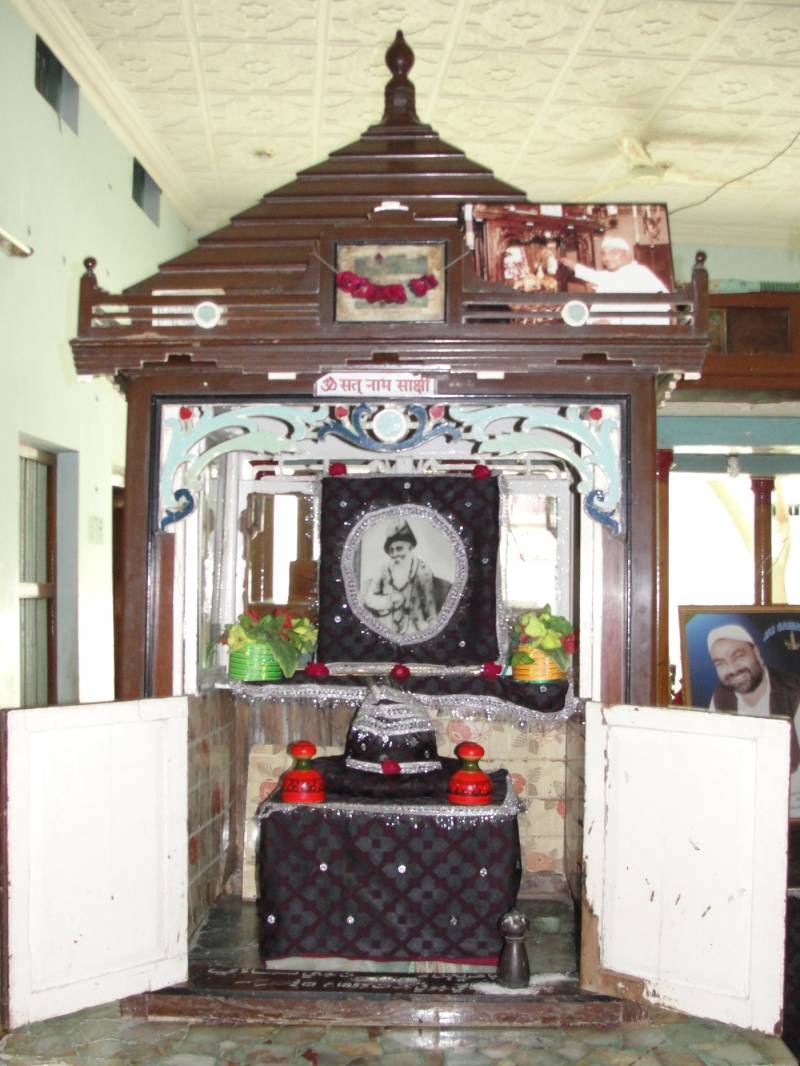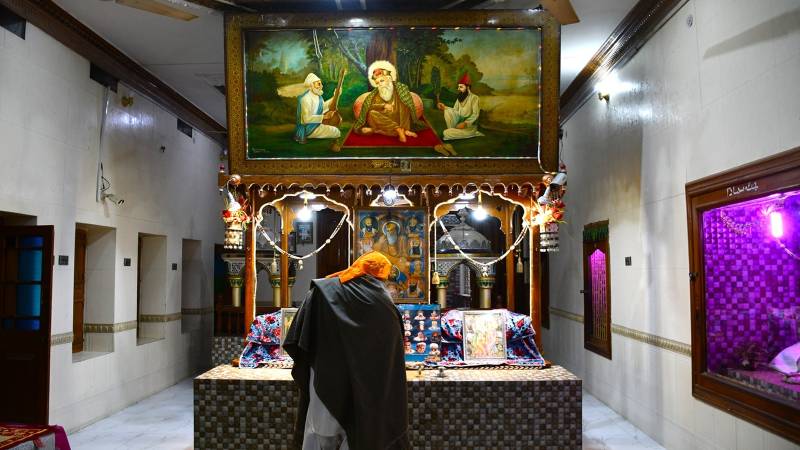
Sindh is home to many Udasi darbars, which are located in various cities, towns, and villages. Shikarpur also has a few Udasi darbars, the most prominent of which is the Pooj Udasin Samadha Ashram. It is one of the largest Udasi darbars in upper Sindh. The Pooj Udasin Samadha Ashram complex includes Dhuni (campfire) darbar, kutiya (room) of Baba Harbhajan, devris (Samadhis), Jhoolo sahib hall, Bhandaro hall, library, orchard, gaushala, Talab (pond), hostel, hospital and other places. It was earlier used as Samshan ghat (cremation ground). This cremation ground became most sacred after Baba Harbhajan established his dhuni and kutiya, where he performed yoga Sadhana (spiritual practice).
Baba Harbhajan was an eminent Udasi saint who came from Amritsar to Shikarpur. According to Samadha Parkash by Bhagwandas L. Wadhwani (2007: 4), Baba Harbajan was born in 1733 in Amritsar. He performed austerities at the Udasi Akharo (monastic establishment) at Amritsar. One day, he set out along with Baba Karamjas to pilgrimage places. He left Amritsar and reached Sukkur in Sindh. After visiting the sacred places of Sukkur, Bakhar and Rohri, he arrived at Shikarpur in 1796 AD. In Shikarpur, Baba Harbhajan established his dhuni at Shamshan ghat (cremation ground). Dhuni (campfire) is the identity of a world renouncer. All the Shivaite trends, be it the Nath, Puri, Giri or Bharti, established dhunis reflecting their identity as world renouncers. Udasi also adopted this ritual from Shaivite renouncers.
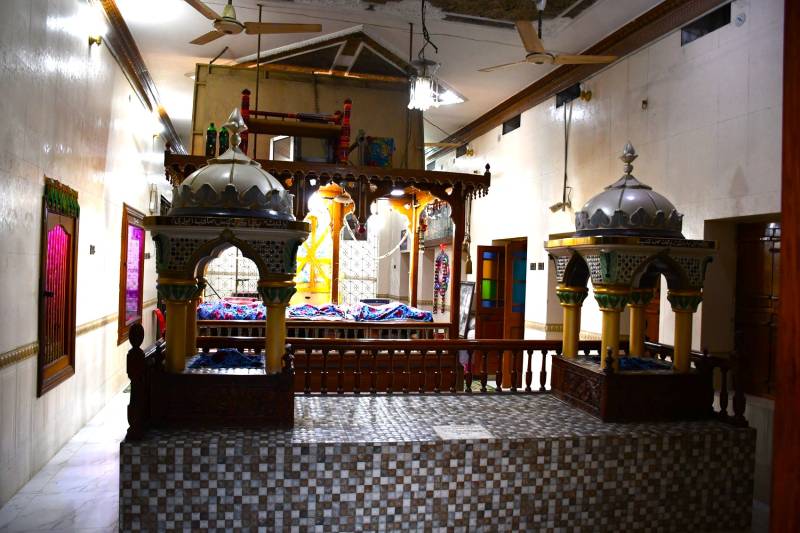
Baba Karamjas Bedi was a descendant of Baba Guru Nanak. Baba Karamjas Bedi was born in 1742 in Chandigarh, Punjab. According to Bhagwandas L. Wadhwani (2007:138), he was believed to have founded a darbar near Chabutra Chowk in Shikarpur, where Satram Dham (SSD) is located today. Baba Karamjas Bedi lived there. During his stay in Shikarpur, he went to Amritsar thrice. He died in 1817 and was buried in the Pooj Udasin Samadha Ashram.
In Lokram Dodeja's book "Munjho Watan Munhinja Manhoon" (1993:93), it is mentioned that Bhai Moolram, who belonged to the family of Bhai Ranjhanmal, was the founder of the Mata Wari Dharamshala near Chabutra Chowk in Shikarpur. He initially established a Darbar in Khairpur, which was later handed over to Gurpotas, particularly to Bawa Gurpat, a descendant of Baba Guru Nanak, who then moved to Hyderabad and established a Darbar there.
In Shikarpur, Bhai Moolram established the Mata Wari Dharamshala, subsequently entrusted it to Gurpotas, and possibly acquired it by Baba Karamjas Bedi. Bhai Moolram later took up residence in an orchard near Sindh Wah, where he died in 1795 and was commemorated with a samadhi at the site.
All the Shivaite trends, be it the Nath, Puri, Giri or Bharti, established dhunis reflecting their identity as world renouncers. Udasi also adopted this ritual from Shaivite renouncers
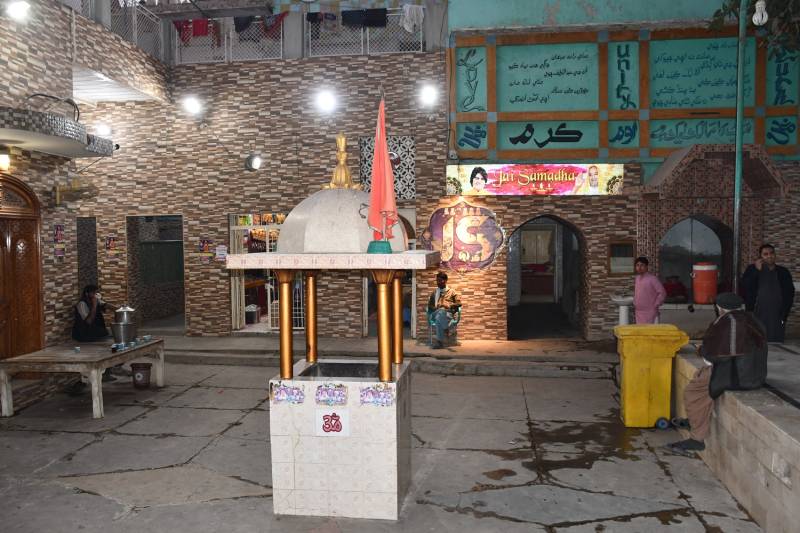
Baba Harbhajan played a pivotal role in propagating the Udasi panth. Through his profound wisdom and spiritual guidance, Baba Harbhajan attracted a significant following of individuals who sought solace and enlightenment in his teachings, ultimately becoming his devoted disciples.
After Baba Harbhajan died in 1853, the Udasi tradition was continued by Baba Ram Bhajan, who succeeded him. He died in 1903 and was succeeded by Baba Roop Bhajan as the third custodian of the Pooj Udasin Samadha ashram. Like his predecessors, Baba Harbhajan and Baba Ram Bhajan, he also spread Udasi panth.
Many people became his disciples. He died in 1916 and was succeeded by Baba Kishan Bhajan, who also played an instrumental role in spreading Udasi panth not only in Sindh but also in Balochistan. He died in 1912 and was succeeded by Baba Gobind Bhajan who died in 1952 and was succeeded by Baba Shiv Bhajan, who died in 2008 and was succeeded by Baba Narain Bhajan.
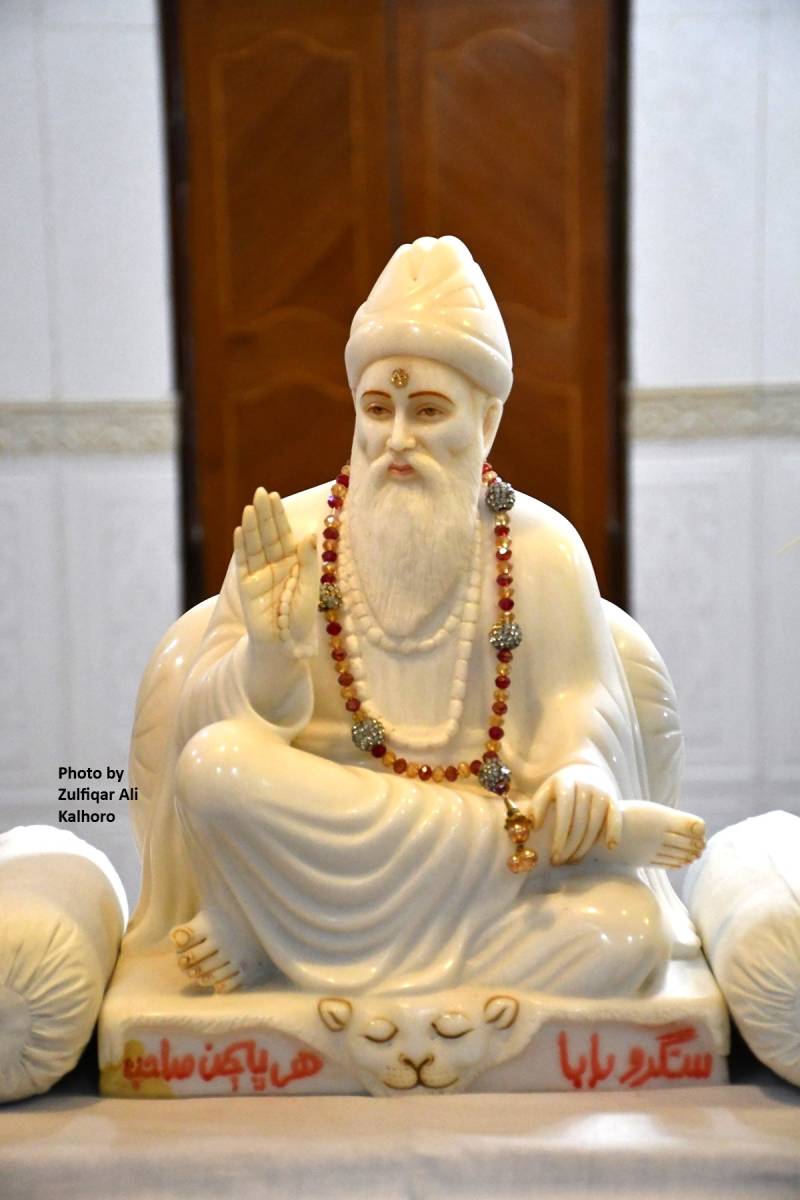
Devris or samadhis of Baba Harbhajan, Baba Ram Bhajan, Baba Roop Bhajan, Baba Kishan Bhajan and Baba Gobind Bhajan are located in the Pooj Udasin Samadha Ashram. I have visited this ashram several times. I first visited it in 1999 and later in 2001, 2002, 2004, 2006, 2009, 2011, 2017, 2019, 2022 and 2023. During these years, I observed that images of Udasi saints were not there from 1999 to 2019; they were placed afterwards. If one visits the Pooj Udasin Samadha Ashram, one is amazed to see the woodwork there. The main wooden doorway opens to the spacious courtyard. The main door is ornately carved and shows both geometric and floral designs. While entering the Pooj Udasin Samadha Ashram, one first notices a dhuni in the centre of the ashram, which is believed to have been established by Baba Harbhajan, the founder of ‘Pooj Samadha Udasin Ashram’. There is also a banyan tree in the Pooj Udasin Samadha Ashram courtyard, where it is believed that Baba Guru Nanak, the founder of Sikkism, once sat. There is also a reception office in the Pooj Udasin Samadha Ashram. The most noticeable thing to observe while entering the reception office of the Pooj Udasin Samadha Ashram is the carved Jhulelal on the wooden door. Jhulelal is shown sitting on a palla fish.
Turning to the left, one can see a Darbar building where Guru Granth Sahib is placed and the image of Baba Sri Chand, Guru Nanak's eldest son and Udasi panth's founder. The image of Baba Roop Bhajan, the third Gadisar of the Pooj Udasin Samadha Asharm, is also found in Darbar. The perpetual lamp of Jhulelal, the Akhand Jyot, is also present in the Darbar. The wooden door of the darbar shows images of Guru Nanak with his two companions, Bhai Bala and Bhai Mardana. The samadhi of Baba Karamjas Bedi is also located in this Darbar building. Adjacent to this samadhi is the devri of Baba Sharan Bhajan, who was a disciple of Baba Roop Bhajan. One can see the wood carving of Guru Nanak with Bhai Bala and Bhai Mardana on both samadhis. The samadhi of Ramtaram is also found to the left of the devri of Baba Karamjas Bedi.
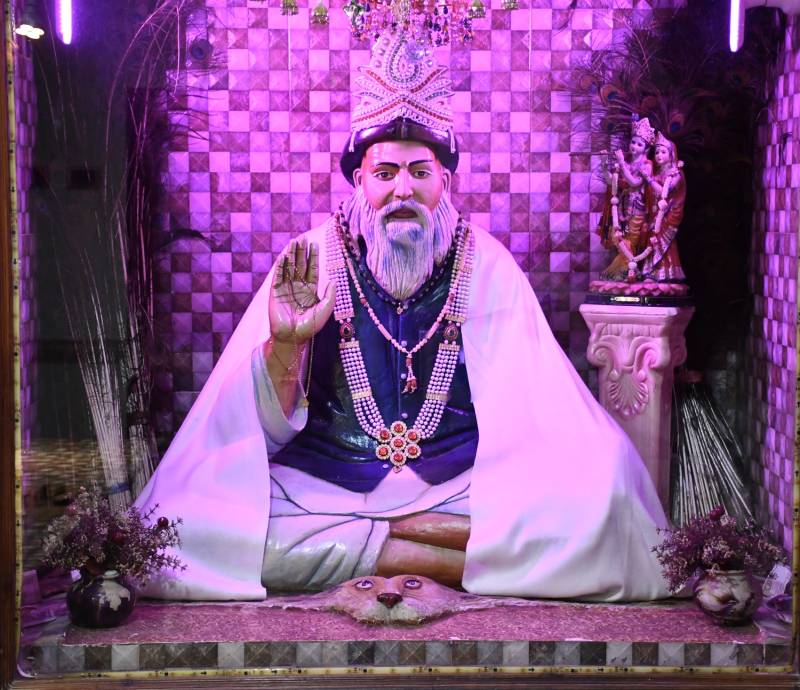
The kutiya (room) of Baba Harbhajan is adjacent to the Darbar building. In this kutiya, Baba Harbhajan used to perform yoga Sadhana. Adjacent to kutiya is a hall that has samadhis of Udasi saints and Gurpotas. The Darshani Darwazo opens to devris/ samadhis of Udasi saints and Gurpotas. The main devri in this hall belongs to Baba Harbhajan, the founder of the Pooj Udasin Samadha Ashram.
The year 1853 is written as the death of Baba Harbhajan on his samadhi. Near this devri is the samadhi of Baba Shiv Bhajan, the sixth Gadisar of the Pooj Udasin Samadha Ashram. He died in 2008. There are five other samadhis built on a platform in a row, which belong to Baba Ram Bhajan, Baba Gobind Bhajan, Baba Roop Bhajan, Baba Kishan Bhajan, and Baba Vishan Bhajan ( a disciple of Kishan Bhajan). The samadhis of Gurpoats are also located in this room. To the north of the devris is located a small temple containing Shiva linga.
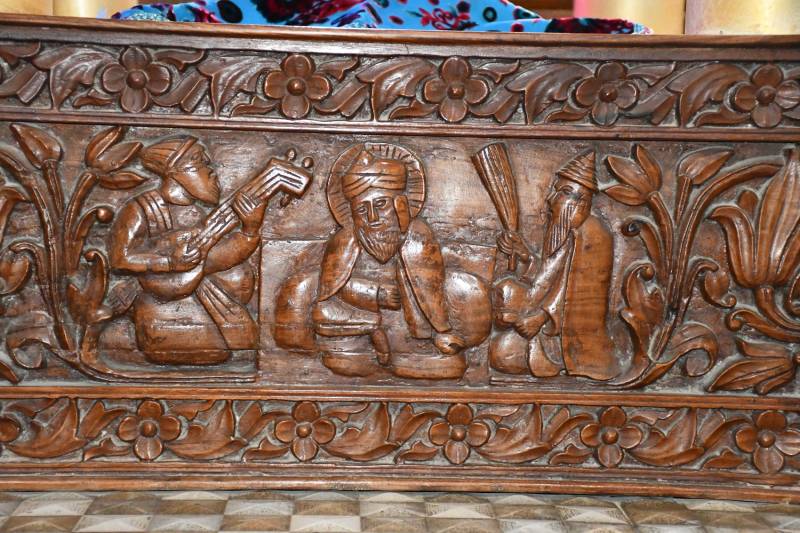
The Darshani Darwazo door depicts the Hindu deities and Baba Guru Nanak. The wood carvings on the Darshani Darwazo at the Pooj Udasin Samadha Ashram are truly impressive. The door has six panels. The first panel shows Shiva, the second one depicts Baba Guru Nanak, the third and fourth panels represent Vishnu and Krishna, and the fifth and sixth panels depict Brahma and Ganpati. Such intricately carved doors with images of Hindu deities and Sikh gurus can also be found in other temples and darbars of Shikarpur.
However, such craftsmanship is rare outside of Shikarpur. This work reflects the unique artistry of doors in Hindu temples and Sikh darbars in Shikarpur. The craftsmanship of the woodwork throughout the Pooj Udasin Samadha Ashram is genuinely remarkable and impressive. Even the Jhoolo (cradle) sahib, located left of the Darbar building of the Pooj Udasin Samadha Ashram, on which hand-written Guru Granth Sahib by Baba Harbhajan is kept, is aesthetically carved depicting Guru Nanak with Bhai Bala and Bhai Mardana. It also depicts Krishna playing the flute, surrounded by birds and animals. I have not seen such intricate wood carvings anywhere else in Sindh, whether in a temple, ashram, darbar, or dharamsala.
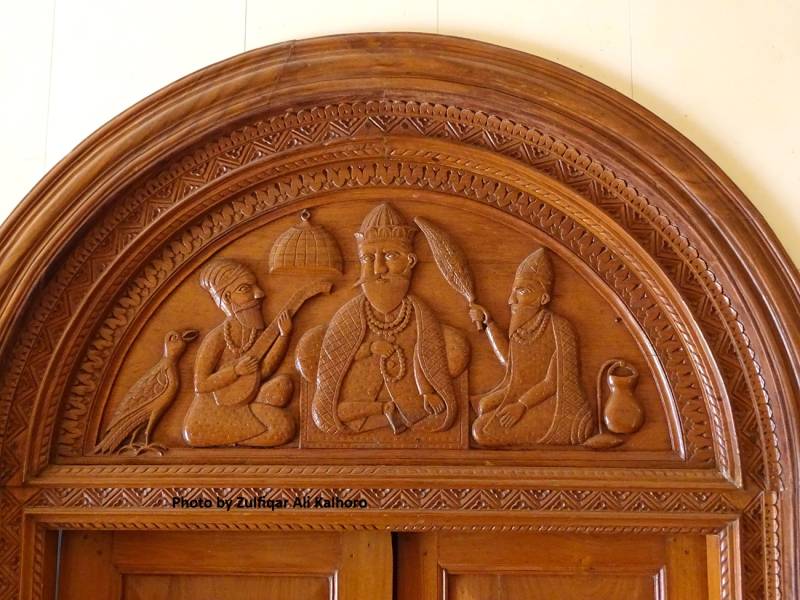
The Udasi saints of the Pooj Udasin Samadha Ashram of Shikarpur represent the enduring legacy and expansion of the Udasi tradition in Sindh, Balochistan, and beyond Pakistan. This spiritual tradition has played a pivotal role in shaping the religious landscape of the region. Notably, numerous branches of the Pooj Udasin Samadha Ashram have been established across India, with significant centres in Kanpur, Hardwar, Indore, Jalgaon, Amravati, Nagpur, and various other towns, each contributing to the propagation of Udasi teachings and practices.
